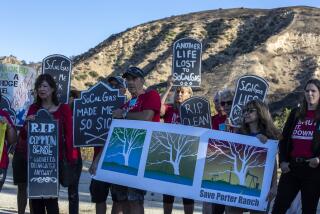Oil Tankers to Avoid Santa Barbara Channel : 3 Firms Announce They Will Reroute Vessels, but Exxon Is Not Among Them
- Share via
SANTA BARBARA — As a result of heightened concern about tanker collisions in the aftermath of the Exxon Valdez disaster in Alaska, three oil companies announced Friday that they will reroute their tankers outside the heavily traveled Santa Barbara Channel.
Spokesmen for Chevron Corp., Mobil Oil Co. and Atlantic Richfield Co. said they will send their tankers outside the environmentally sensitive channel. But three other companies, including Exxon, have made no decision about changing the routing, which was requested by an area congressman.
“We’re still in the process of developing a position,” Exxon spokesman Brian Dunphy said. “We’ll be responding to this issue in the near future.”
Environmentalists Angered
Santa Barbara environmentalists were incensed that Exxon did not join the other oil companies in rerouting their tankers.
“If anybody should be taking safer routes, it should be Exxon,” said Vaughan Parker of the Santa Barbara Sierra Club. “Considering they’re history in Alaska, it’s unbelievable they’re holding out.”
Chevron and Mobil decided to reroute their tankers in response to a request by Rep. Robert J. Lagomarsino (R-Ventura), company spokesmen said. Lagomarsino said he sent letters to six oil companies--responsible for most of the tanker traffic in the channel--on April 25, requesting that they avoid the channel because it is an environmentally sensitive area and heavily traveled.
Arco, a company spokesman said, had already decided to reroute its tankers before it was contacted by the congressman. Unocal, British Petroleum and Exxon have not made a decision yet.
“There is a higher degree of attention now paid to tanker operations in the wake of the Valdez,” said T. R. Moore, vice president of Chevron Shipping Co., at a press conference Friday in Santa Barbara. “The farther you are from things you can hit--like other ships or land--the safer you are.”
While local environmental organizations commend the oil companies that rerouted their tankers, they say much more needs to be done to prevent oil spills. An average of 23 vessels a days pass through the channel, and only about three are tankers, according to Santa Barbara county statistics.
The channel runs about 80 miles from Point Conception on the north to Port Hueneme on the south, between the mainland and the Channel Islands.
According to a report prepared for the Santa Barbara County Energy Division, there is a significant likelihood “of approximately two very severe oil spills occurring during the next decade.”
When the draft of the report was released in February, oil industry officials were “very upset with the study,” said Bruce Carter, a planner with the county energy division. They remain skeptical of the results, Carter said, but after the Valdez disaster, “they have a different attitude. They know the danger out there and they’re more willing the address the issues.”
Even if all the tankers are rerouted out of the channel, there is still the danger of other vessels, some carrying toxic cargo, colliding and there is the danger of vessels striking oil platforms, said Elise Dale, executive director of Citizens Planning Assn., a local environmental lobbying organization.
“The rerouting isn’t a cure-all,” Dale said. “We’d like to see more pipelines in the Santa Barbara area, more double-hulled tankers and smaller tankers that are more navigable.”
Safety System Proposed
Robert Almy, head of the county energy division, said a “mandatory vessel control system,” which is similar to an air traffic control system, would best the safest way to control the vessels in the Santa Barbara Channel. This type of system is used in Puget Sound and four other channels in the country, he said.
Lagomarsino has proposed federal legislation banning Alaskan oil tankers from the channel unless they have a destination in the channel, but oil companies have resisted the change because of the additional cost. Chevron estimated Friday that it would cost the company about $500,000 a year to route around the channel, which adds about 50 miles and four hours sailing time to each round trip.
On a related issue, Rep. Barbara Boxer (D-Greenbrae) announced Friday that the U.S. Coast Guard has agreed to hold public hearings in San Francisco this summer to study a controversial sea lane being proposed off California’s Central Coast. The hearings will review the size, location and configuration of the tanker safety lane, which federal law requires before the Department of the Interior can sell more offshore oil leases.
The Coast Guard originally planned a five-mile-wide lane from Santa Barbara north to the Ano Nuevo State Reserve, but reduced it to accommodate additional drilling platforms after the Interior Department objected. Now under study are two lanes, each a mile wide, separated by a median of platforms.
Boxer said the new plan greatly increases the likelihood a tanker would run into a platform, an event she said has occurred 93 times since 1970. She added that the Exxon Valdez was 1 1/2 miles off course when it ran aground in Alaska in March.
More to Read
Sign up for Essential California
The most important California stories and recommendations in your inbox every morning.
You may occasionally receive promotional content from the Los Angeles Times.










